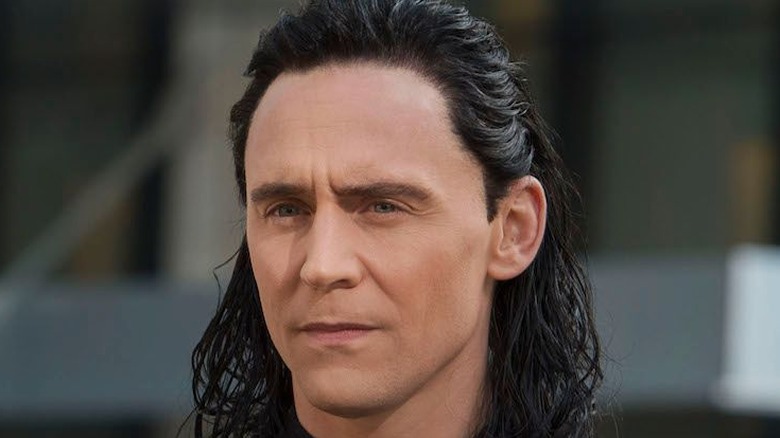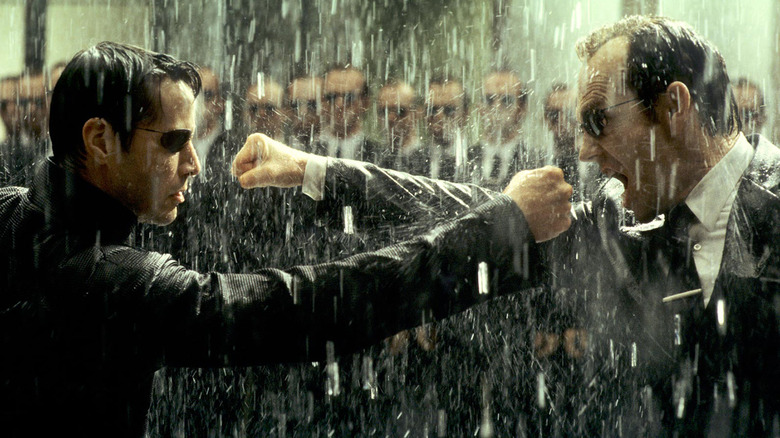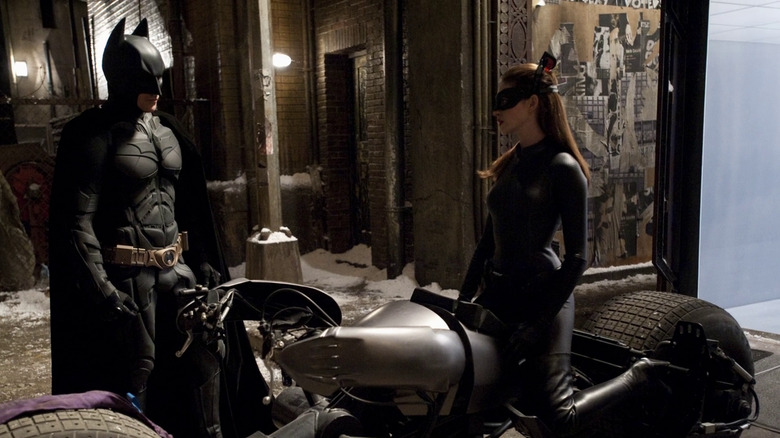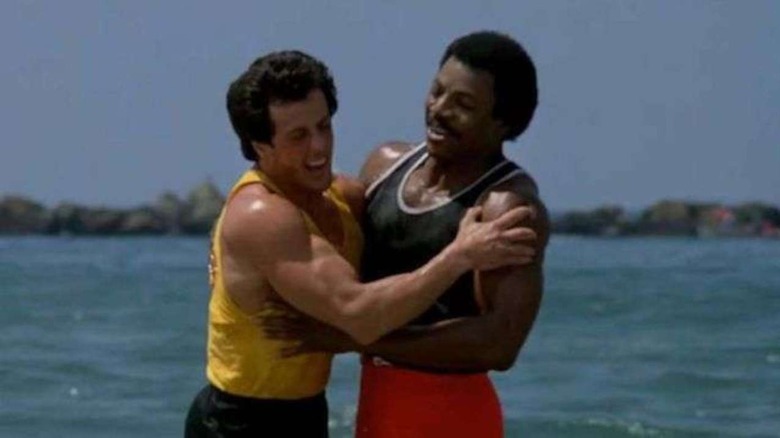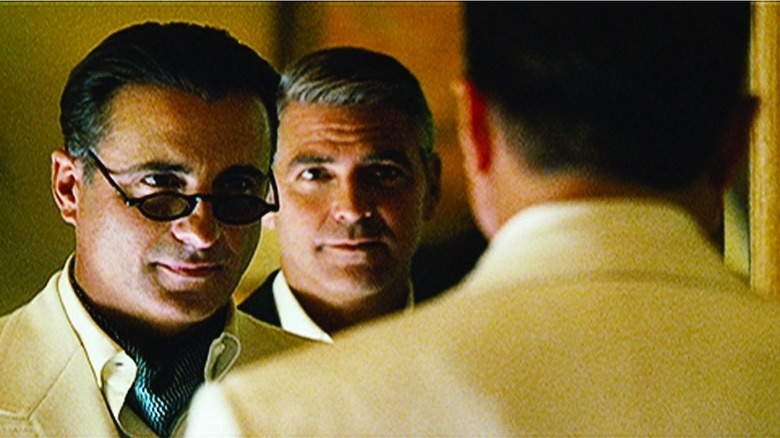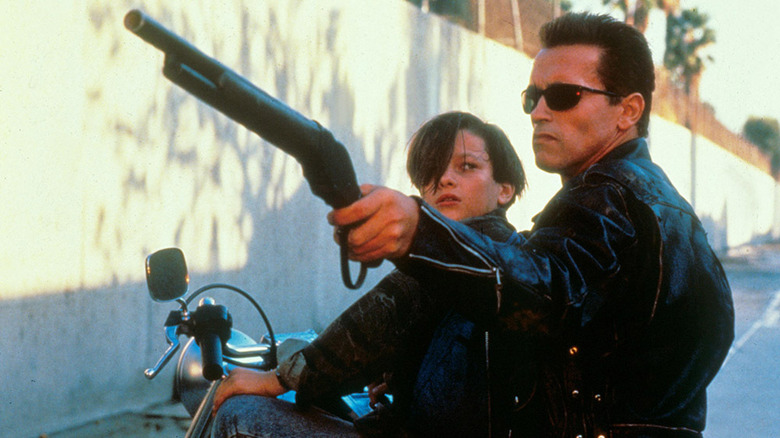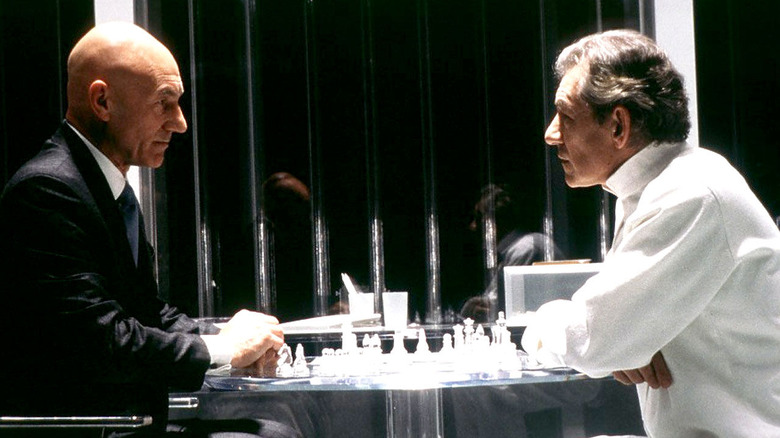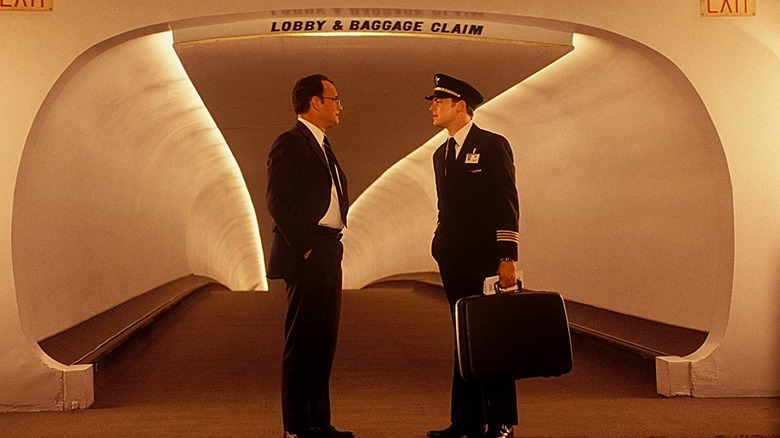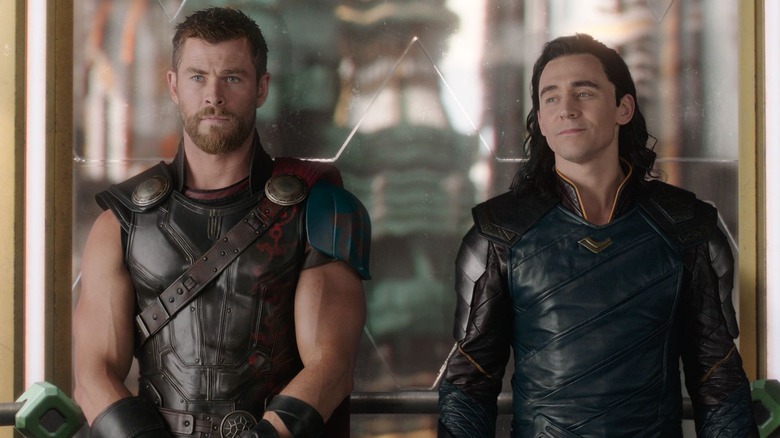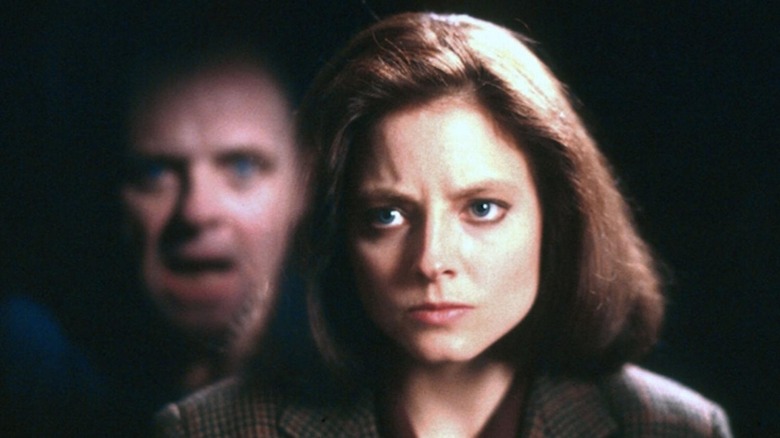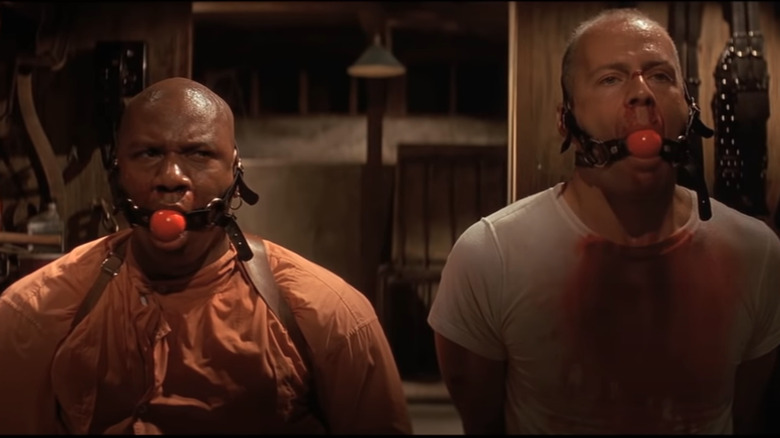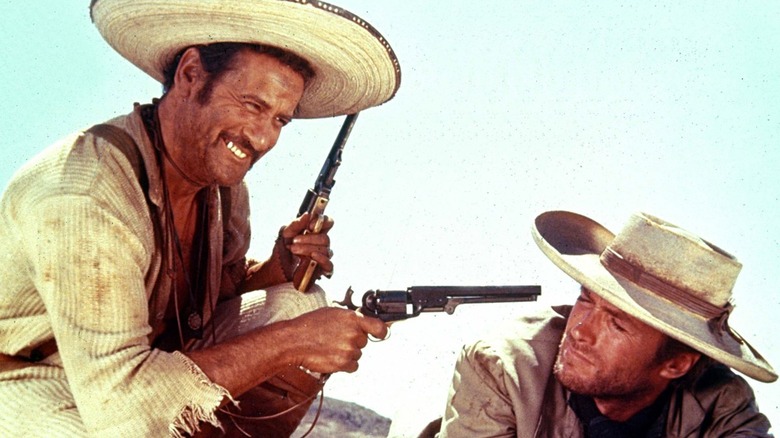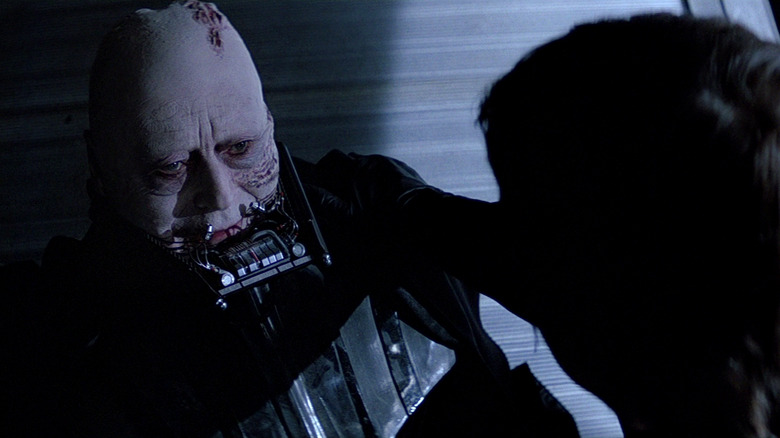The Best Good Guy-Bad Guy Team-Ups In Movie History
Good guys have been fighting bad guys since the very first stories were told. Generally speaking, we root for the protagonist and against the antagonist. The latter's presence gives the hero's journey stakes, depth, and growth. Though this formula has been around for thousands of years, it's certainly possible to tweak. Sometimes, tweaking is even necessary. When a movie franchise grows a bit long in the tooth, constantly introducing new villains, each of whom has to challenge the hero in new ways, can get tiring. Watching the same bad guy fill the role of antagonist multiple times in a row can also become boring. Furthermore, tossing a worthy foe aside once they've been beaten often feels like a waste, especially if the character proves to be a fan favorite.
To avoid these pitfalls, many movies force heroes and villains to band together. This might be out of necessity, to defeat a common threat, or because the bad guy has had a change of heart. Whatever the reason, if done right, a team-up of this nature can lead to unforgettable stories. Which movies pull off this sort of unlikely alliance best? We've assembled this list of the greatest good guy-bad guy team-ups in movie history to answer that very question.
Neo and the Machines – The Matrix Revolutions
In the first "Matrix" movie, we learn that the world is a simulation run by the Machines, built to placate humanity while their bodies are used as batteries. You could make the argument that these robots aren't really "bad guys" in the traditional sense: "The Animatrix" makes it clear that humanity started the war that led to this mess and blocked out the sun to starve the Machines of an energy source when the fight went south. After winning, the Machines even created a pleasant virtual reality for humanity to live in. Awww?
Regardless, the Machines serve as deadly foes to Neo (Keanu Reeves) and his allies. Moreover, inside the Matrix, our heroes face another threat in the form of Agents — programs designed to maintain order and prevent humans from realizing the truth. One of them, Agent Smith (Hugo Weaving), gets "unplugged" from the system and proceeds to copy himself like a cancer. He eventually threatens the Matrix itself, as well as the Machines who run it.
Neo strikes a deal with the Machines: In exchange for Zion's safety, he'll handle Smith. He goes on to sacrifice himself to save both the Machines and humanity, thus fulfilling the prophecy of "The One."
Batman and Catwoman – The Dark Knight Rises
Eight years after the events of "The Dark Knight," Bruce Wayne (Christian Bale) is a recluse and nobody's seen Batman in nearly a decade. At a party, Selina Kyle, a.k.a. Catwoman (Anne Hathaway), sneaks into Wayne Manor and steals Bruce's fingerprints for his competitor, John Daggett, who's looking to exert control over Wayne Enterprises. After her relationship with Daggett sours, Catwoman teams up with a resurfaced Batman just long enough to betray him to Bane (Tom Hardy), the terrorist who's pulling all the strings, in exchange for her own safety. It's a pretty lousy start for a relationship that ultimately turns friendly, and, in time, romantic.
After a brutal battle, Bane imprisons Batman in a desolate, open-air prison on the other side of the world. He proceeds to hold Gotham hostage with a nuclear bomb. When Batman returns, he recruits Selina in his effort to evacuate the city and defeat Bane before the bomb goes off. She's surprised by his proposal, given their history and her checkered past. But soon enough, their team-up makes for an epic climax in which she saves Bruce's life, helps him get the bomb out of the city, and ultimately runs away with him to Europe.
Rocky and Apollo Creed – Rocky III
This foe-to-friend arc takes place over the course of several movies. In 1976's "Rocky," Rocky Balboa (Sylvester Stallone), a loan shark's debt collector and underground boxer, gets a chance to rise out of poverty by fighting world heavyweight champion Apollo Creed (Carl Weathers). You all know the story: Rocky trains passionately and ultimately holds his own against Creed, barely losing while earning global attention and respect. In 1979's "Rocky II," Rocky fights Creed again after the latter man launches a smear campaign against him in reaction to public rumors that their now-legendary 1976 match was fixed in his favor. This time, Rocky takes the belt fair and square.
1982's "Rocky III" takes place a few years later. Rocky is now an international boxing superstar who's defended his title multiple times. But now there's a new threat: James "Clubber" Lang (Mr. T), a ruthlessly powerful up-and-comer with his eyes on the prize. In their first match, Lang dominates Rocky, who's out of practice and distracted by his friend Mickey's impending death. Surprisingly, Apollo Creed himself offers to train Rocky for the rematch he ultimately wins, beginning a lifelong friendship. Years later, as seen in the "Creed" movies, Rocky returns the favor by training Apollo's son (Michael B. Jordan).
Ocean's team and Benedict – Ocean's Thirteen
In 2001's "Ocean's Eleven," Danny Ocean (George Clooney) and his star-studded team of thieves rob a series of Las Vegas casinos owned by Terry Benedict (Andy Garcia). In the 2004 sequel, "Ocean's Twelve," Benedict locates each member of the team and demands they pay back the $160 million they stole. This forces them to stage more heists. The movie ends with everyone on frosty, but stable, terms.
In 2007's "Ocean's Thirteen," another baddie pops up in the form of Willy Bank (Al Pacino), a ruthless casino mogul and Benedict's rival. His thugs give Ocean's friend Reuben Tishkoff a heart attack when they storm into his home. Ocean and his boys decide to plan their revenge, with Benedict getting in on the fun. Their plan revolves around rigging the machines in Bank's new casino to pay out exorbitant sums to undeserving players (among other, smaller objectives), thus ruining Bank. After this is accomplished, Ocean adds the cherry on top of the vengeful sundae by reminding Bank that there's not much he can do to get back at them: All of Bank's associates prefer Ocean and Benedict, and given his illegal activities, he can't get the cops involved. It's a killer ending to one of the best trilogies of the 2000s.
The Connors and the Terminator – Terminator 2: Judgment Day
In 1984's "The Terminator," Arnold Schwarzenegger's titular time-traveling android murder machine very nearly kills Sarah Connor (Linda Hamilton), who will give birth to a son destined to lead the resistance movement against Skynet, the A.I. program that will eventually take over the world (and send the Terminator back in time in the first place). That's already a lot to take in, but as fans of the long-running sci-fi franchise know, it doesn't get any less complicated.
In the sequel, 1991's "Terminator 2: Judgment Day," Skynet sends an improved Terminator, the T-1000 (Robert Patrick), to do what the old Model 101 (Schwarzenegger) couldn't: Prevent the resistance movement from forming. This time, the target is Sarah's son John Connor, who she's been preparing for combat since birth. Luckily for him, his future self sends back a reprogrammed Model 101 to protect him.
This time, Schwarzenegger's classic Terminator and the Connors team up against the new and improved model, made of shape-shifting "liquid metal." The good guys win, but only just, and not before Schwarzenegger's Model 101 takes some serious damage. Still, a victory's a victory. "T2" is the high point of the entire series, surpassing even the classic original film in terms of epic action set pieces and deep character development for both the human and cyborg characters.
Professor X and Magneto – The X-Men films
Professor Charles Xavier (Patrick Stewart and James McAvoy), leader of the X-Men, hopes that one day, the team's day-saving superheroics will inspire humans to trust their misunderstood kind. Meanwhile, his childhood friend Erik Lehnsherr (Ian McKellen and Michael Fassbender), a Holocaust survivor who can control metal, wants to liberate mutants from human discrimination as the terrorist Magneto. Whenever the question of how to further the interests of mutantkind rises, you can expect these two, along with their respective underlings, to clash in epic battles. That's pretty much the backone of the "X-Men" films.
But certain threats are so extreme that they force Professor X and Magneto to put their differences aside and cooperate. Such is the case in 2003's "X2," when Colonel Stryker (Brian Cox) tries to exterminate all mutants. It happens again in 2011's "X-Men: First Class," when they try to stop the Cuban Missile Crisis from escalating into World War III. The pair reunites in 2014's "X-Men: Days of Future Past" when the X-Men travel through time to prevent a mutant apocalypse. And wouldn't you know it, 2016's "X-Men: Apocalypse" sees them team up once more, when En Sabah Nur (Oscar Isaac) threatens to destroy the world.
Basically, Professor X and Magneto are pals as often as they're foes ... even though most of these team-ups involve them clashing at one point or another.
Frank and Carl – Catch Me If You Can
2002's "Catch Me If You Can" follows the criminal misadventures of Frank Abagnale (Leonardo DiCaprio), a con man whose talents for check fraud and bluffing lead FBI agent Carl Hanratty (Tom Hanks) on a thrilling, multi-year chase across the country.
Over the course of the movie, Abagnale poses as a pilot for Pan American World Airways, a doctor in Georgia, and a parish prosecutor in Louisiana, among other positions. Along the way, he falls in love, takes and passes the bar exam, and travels the world — all while forging increasingly impressive checks.
Of course, Hanratty is hot on his trail. He ultimately catches and briefly imprisons the elusive Abagnale. As part of a deal, Abagnale is allowed to finish his sentence by volunteering for the FBI's bank fraud unit. His extensive personal expertise advances multiple cases. At the time of the movie's release, the real Abagnale had been working with the Feds for decades. During those years, he was also friends with the real Hanratty, a man named Joseph Shea. That's right: It's an amazing (if embellished) true story.
Thor and Loki – Multiple MCU movies
Loki, Thor's adopted brother and the fan-favorite god of mischief, proved to be the breakout star of 2011's "Thor." The revelation of his true parentage sends him spiraling into villainy. In 2012's "The Avengers," Loki leads an alien invasion of Earth in the hopes of dominating the planet. It's the last time he serves as the main antagonist, although he does serve as a secondary villain in several other MCU movies.
In 2013's "Thor: The Dark World," Loki and Thor team up to save the Nine Realms from the Dark Elves. Though that film is commonly regarded as one of the MCU's weakest installments, the brothers' alliance is too thematically rich to ignore. Thus, the pair reunites in 2017's "Thor: Ragnarok." Loki betrays Thor multiple times, because of course he does, but the duo ultimately works together to defeat their evil sister Hela, the exiled goddess of death. Things take a dark turn in the opening sequence of 2018's "Avengers: Infinity War" when Loki is killed by Thanos. That isn't the end for the brothers, however, as 2021's "Loki" series makes clear.
Loki is fundamentally untrustworthy, but he's certainly capable of growth and compassion. We're not sure if his brief bursts of heroism will ever completely stick, but his story remains ongoing. Hopefully, the future will include plenty more team-ups between Asgard's most complex sibling pair.
Hannibal and Clarice – The Silence of the Lambs
Contrary to popular belief, Hannibal Lecter (Anthony Hopkins) is not the primary villain of Jonathan Demme's 1991 masterpiece, "The Silence of the Lambs." After all, the notorious cannibal is already in prison when Clarice Starling (Jodie Foster), an FBI rookie on the hunt for the enormously creepy Buffalo Bill (Ted Levine), visits him for advice. Lecter, who grows to respect Starling's intelligence and dedication, ultimately cooperates by drip-feeding her insights into the mind of a madman only another deranged killer could provide.
None of this is to say that Lecter has a fundamental change of heart, or that he does nothing supremely evil over the course of the film. On the contrary: Lecter delights in misleading and psychologically tormenting anyone unlucky enough to get caught in a conversation with him. Ultimately, he murders his guards and escapes to a future assuredly filled with murder and people-eating. But the ultimate demise of Buffalo Bill, who turns out to be a vicious man named Jame Gumb, wouldn't have been possible without him.
Butch and Marsellus Wallace – Pulp Fiction
In Quentin Tarantino's 1994 masterpiece "Pulp Fiction," Butch (Bruce Willis), an underground boxer, accepts a bribe from local gangster Marsellus Wallace (Ving Rhames) to lose in an upcoming match. He ultimately bets the cash on himself and wins, doubling his take and double-crossing Wallace. But of course, as the endlessly quotable opening sequence makes abundantly clear, Marsellus Wallace isn't to be trifled with. The crime lord sends hitmen after Butch, who's trying to escape with his girlfriend and lay low. Butch manages to throw every tail and even get the drop on Vincent Vega (John Travolta), one of Wallace's goons.
But just when it looks like he's in the clear, he and Wallace clash after accidentally spotting each other in traffic. Their gunfight goes back and forth for a bit before Wallace chases Butch into a pawn shop. Their brawl is brought to a halt when the store owner captures both men with a shotgun and brings them to the basement.
Butch manages to escape, but decides to go back and save Wallace with a katana. Together, the two former foes kill their captors in an outrageously bloody climax. Wallace tells Butch they're even and lets him go, on the condition that he leave Los Angeles and never tell anyone what happened. It's an epic, unpredictable ending to one of the greatest films of the 1990s.
Blondie and Tuco – The Good, The Bad, and the Ugly
These on-again-off-again partners meet when bounty hunter Blondie, a.k.a. The Man with No Name (Clint Eastwood), delivers Tuco (Eli Wallach), an oafish but surprisingly resourceful Mexican bandit, to a local sheriff for a reward. However, Blondie pities Tuco and frees him before his execution ... only to strand him in the desert when he won't stop complaining. Tuco gets revenge by capturing Blondie and nearly killing him in a forced march across the desert. For obvious reasons, there's a lot of bad blood between them.
But then, the men become aware of a cache of Confederate gold, buried in a nearby graveyard. They both know where the graveyard is, but only Blondie knows which headstone the treasure is under. Wanting to find the gold themselves before the sadistic Angel Eyes (Lee Van Cleef) gets to it, they agree to work together. But there's plenty more backstabbing to be had along their journey.
In the end, Blondie shoots Angel Eyes, gets the gold, and spares Tuco's life, despite Tuco's attempts to abandon him and find the gold himself. Their relationship doesn't exist entirely out of necessity: Though they can't work together long term, they do seem to care about each other. It's one of the more fascinating relationships in movie history.
Luke and Vader – Star Wars: Return of the Jedi
While many good guy-bad guy team-ups are fun twists in service of a larger story, Luke's journey to save his father from the dark side is the entire point of the original "Star Wars" trilogy. Though the actual team-up lasts only a few minutes towards the end of 1983's "Return of the Jedi," it resonates throughout the franchise.
As the film reaches its climax, Emperor Palpatine has lured the Rebel fleet into a trap, using a supposedly vulnerable second Death Star as bait. Rebel and Imperial forces fight on the surface of Endor and in the void of space in the ultimate struggle for galactic control. It's a whirlwind of blockbuster action — but the real story happens in the Death Star's throne room, where Luke and Vader duel.
Luke ultimately wins their battle, but he refuses to slay his father. Inspired by his son's refusal to join the dark side, even as he's electrocuted by the Emperor, Vader hurls Palpatine to his death. He proceeds to die in his son's arms as a redeemed man. It's the greatest, most triumphant moment in the entire saga. Moreover, it still holds up today, even taking Emperor Palpatine's improbable survival, revealed in 2019's "The Rise of Skywalker," into account.
